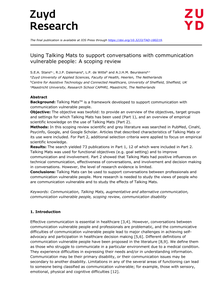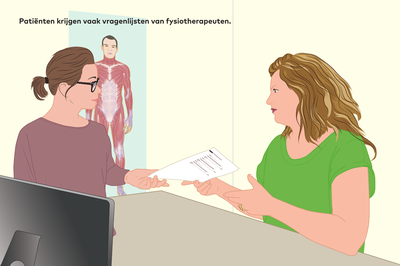Background: Talking Mats is a framework developed to support communication with communication vulnerable people. Objective: The objective was twofold: to provide an overview of the objectives, target groups and settings for which Talking Mats has been used (Part 1), and an overview of empirical scientific knowledge on the use of Talking Mats (Part 2). Methods: In this scoping review scientific and grey literature was searched in PubMed, Cinahl, Psycinfo, Google, and Google Scholar. Articles that described characteristics of Talking Mats or its use were included. For Part 2, additional selection criteria were applied to focus on empirical scientific knowledge. Results: The search yielded 73 publications in Part 1, 12 of which were included in Part 2. Talking Mats was used for functional objectives (e.g. goal setting) and to improve communication and involvement. Part 2 showed that Talking Mats had positive influences on technical communication, effectiveness of conversations, and involvement and decision making in conversations. However, the level of research evidence is limited. Conclusions: Talking Mats can be used to support conversations between professionals and communication vulnerable people. More research is needed to study the views of people who are communication vulnerable and to study the effects of Talking Mats.
DOCUMENT

Presentation given at the online conference Talking the Cyprus Issue Togehter : Maritime Disputes in the Eastern Mediterranean - Session 2
MULTIFILE

The traditional paternalistic approach in health care is increasingly developing towards a patient-centered care (PCC) approach. However, not all patients are able to take advantage of the positive effects of PCC. Inadequate health literacy (HL) is an important limiting factor in the ability of patients to take on an active role and exchange information with their health care provider effectively. A provenly effective approach to improvement of provider-patient interaction and health outcomes is the use of health-related questionnaires. The aim of the research project described within this thesis was to adapt the most frequently-used questionnaire in Dutch physical therapy practice and add information and communication technology to it. A Dutch and Turkish version of the tool called Talking Touch Screen Questionnaire (TTSQ) was developed and evaluated on both usability and validity aspects. The current prototype of the tool does not yet fully solve the problems native and minority patients with low (health) literacy have with completing the adapted questionnaire. Big challenges in future development and testing the TTSQ are the recruitment of vulnerable members of the hard-to-reach native and minority target populations and finding research methods that suit the abilities and needs of these participants. This is expected to be a very challenging, labor- and time-consuming process. On the other hand, having a usable, valid and reliable TTSQ may well save a lot of time and money in both research and clinical practice in the future.
DOCUMENT

-Chatbots are being used at an increasing rate, for instance, for simple Q&A conversations, flight reservations, online shopping and news aggregation. However, users expect to be served as effective and reliable as they were with human-based systems and are unforgiving once the system fails to understand them, engage them or show them human empathy. This problem is more prominent when the technology is used in domains such as health care, where empathy and the ability to give emotional support are most essential during interaction with the person. Empathy, however, is a unique human skill, and conversational agents such as chatbots cannot yet express empathy in nuanced ways to account for its complex nature and quality. This project focuses on designing emotionally supportive conversational agents within the mental health domain. We take a user-centered co-creation approach to focus on the mental health problems of sexual assault victims. This group is chosen specifically, because of the high rate of the sexual assault incidents and its lifetime destructive effects on the victim and the fact that although early intervention and treatment is necessary to prevent future mental health problems, these incidents largely go unreported due to the stigma attached to sexual assault. On the other hand, research shows that people feel more comfortable talking to chatbots about intimate topics since they feel no fear of judgment. We think an emotionally supportive and empathic chatbot specifically designed to encourage self-disclosure among sexual assault victims could help those who remain silent in fear of negative evaluation and empower them to process their experience better and take the necessary steps towards treatment early on.
We had been involved in the redesign of the 4 Period Rooms of the Marquise Palace, also called the Palace of Secrets, in Bergen op Zoom. This design was based on the biography of a historical figure: Marie Anne van Arenberg, whose dramatic life was marked by secrets. Each of the 4 rooms represents a turning moment in Marie Anne’s story: the official marriage, the secret marriage and the betrayal, the dilemma and choice, with, in a final room, the epilogue. These different episodes are reflected in the way the rooms are furnished: the ballroom, the bedroom, the dining room. The Secret Marquise as design and exhibition has brought more visitors to the museum. As designers and researchers, however, we were interested in understanding more about this success, and, in particular, in understanding the visitors experience, both emotionally and sensorially at different moments/situations during the story-driven experience.In the fall of 2021, the visitors’ lived experience was evaluated using different approaches: a quantitative approach using biometric measurements to register people’s emotions during their visit, and a qualitative one consisting of a combination of observations, visual imagery, and interpretative phenomenological analysis (IPA).Qualitatively, our aim was to understand how respondents made sense of Marie Anne’s story in the way in which this was presented throughout the exhibition. We specifically looked at the personal context and frame of reference (e.g., previous experiences, connection to the visitor’s own life story, associations with other stories from other sources). In the design of the rooms, we used a combination of digital/interactive elements (such as a talking portrait, an interactive dinner table, an interactive family painting), and traditional physical objects (some 17th century original objects, some reproductions from that time). The second focal point of the study is to understand how these different elements lead the visitors experience.
Het aantal personen dat onder bewind staat is tussen 2009 en 2018 ruim verdubbeld van 97.000 naar 242.000 personen. Het probleem is dat bewindvoerders per cliënt 17 uren per jaar hebben, wat vaak net voldoende is om de financiële zaken te regelen. De sociale cohesie en het aanleren van financiële competenties schiet hierdoor te kort, waardoor dit grote gevolgen heeft voor de relatie onderling. Bewindvoerders en financiële hulpverleners zijn opzoek naar nieuwe manieren om personen onder bewind/financiële problemen in beweging te krijgen, te motiveren en het gedrag positief te beïnvloeden. Dit tot doel dat ze de drie kerncompetenties voor financieel zelfredzaamheid die door het Nibud zijn vastgelegd stap voor stap aanleren en in de praktijk kunnen toepassen. In de afgelopen 2,5 jaar hebben de projectpartners verschillende onderzoeken uitgevoerd. Tijdens de Take-off hbo is de doelstelling om de resultaten en onderzoeken met bewindvoerders en personen onder bewind, uit te werken tot de prototype Talking Money dat kan worden getest met bewindvoerders en overige belanghebbende.